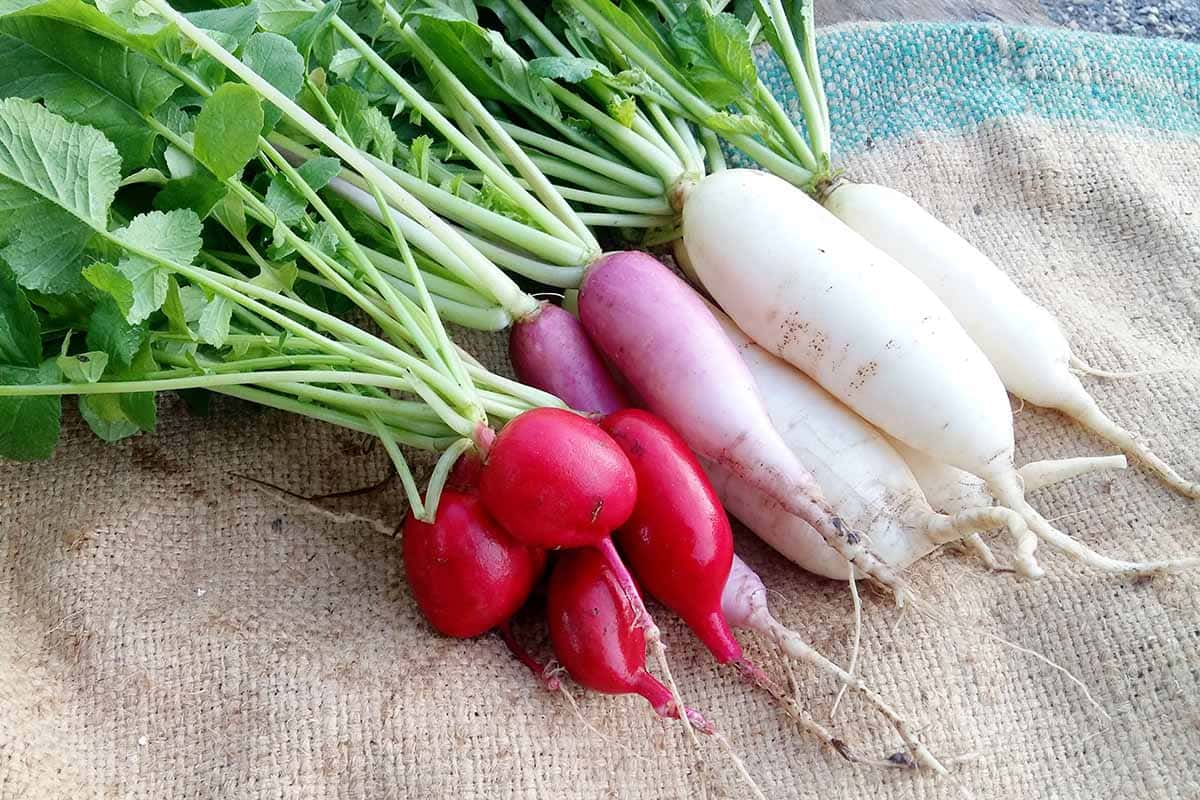Picture this: It’s December, your garden beds are mostly bare, and you’re craving something fresh and crunchy from your own plot. While most gardeners resign themselves to storage crops and grocery store produce, there’s a vibrant, versatile vegetable thriving in the cold soil, just waiting to be discovered.
Enter the winter radish—a completely different beast from those petite spring varieties you know, and arguably far more interesting.
If you’ve only experienced those quick-growing, marble-sized red radishes, you’re in for a revelation. Winter radishes are the marathon runners of the radish world: larger, sturdier, and packed with possibilities that extend far beyond salad garnishes.
By the end of this guide, you’ll understand why these cold-loving roots deserve a permanent spot in your fall garden rotation and how to grow them successfully for months of fresh harvests.
What Makes Winter Radishes Different?
Winter radishes belong to the same species as their spring cousins (Raphanus sativus), but they’ve evolved to thrive in completely different conditions. While spring radishes race from seed to plate in three to four weeks, winter varieties take a more leisurely eight to twelve weeks to mature.
This slower development allows them to grow substantially larger—some varieties can reach softball size or even bigger—while developing a denser, starchier texture.
The key distinction lies in their relationship with temperature. Spring radishes bolt and turn bitter when days heat up and stretch past ten hours of sunlight.
Winter radishes, however, actually prefer the shortened days and cooling temperatures of late summer and fall. Many varieties even sweeten after exposure to frost, transforming from merely peppery to complex and nuanced in flavor.
Unlike their delicate spring relatives that must be pulled promptly or risk becoming pithy and unpleasantly hot, winter radishes can sit patiently in the ground for weeks after reaching maturity.
They’re remarkably forgiving, maintaining crisp texture and fresh flavor well into winter, especially when protected with a layer of mulch. This extended harvest window means you can pull roots as needed rather than scrambling to use them all at once.
Varieties Worth Growing
The world of winter radishes offers remarkable diversity in size, shape, color, and flavor intensity. Here are the standouts:
Black Spanish Round
This heritage variety has graced gardens since the 16th century, forming tennis ball-sized spheres with rough, coal-black skin that conceals bright white, crisp flesh. When raw, it packs a serious punch—one of the spiciest radishes you’ll encounter—but cooking mellows it beautifully.
Think of it as the bold personality of the winter radish family, perfect for stews, soups, and roasting alongside other root vegetables. Its high vitamin C content once made it a scurvy-preventing staple for European peasants through harsh winters.
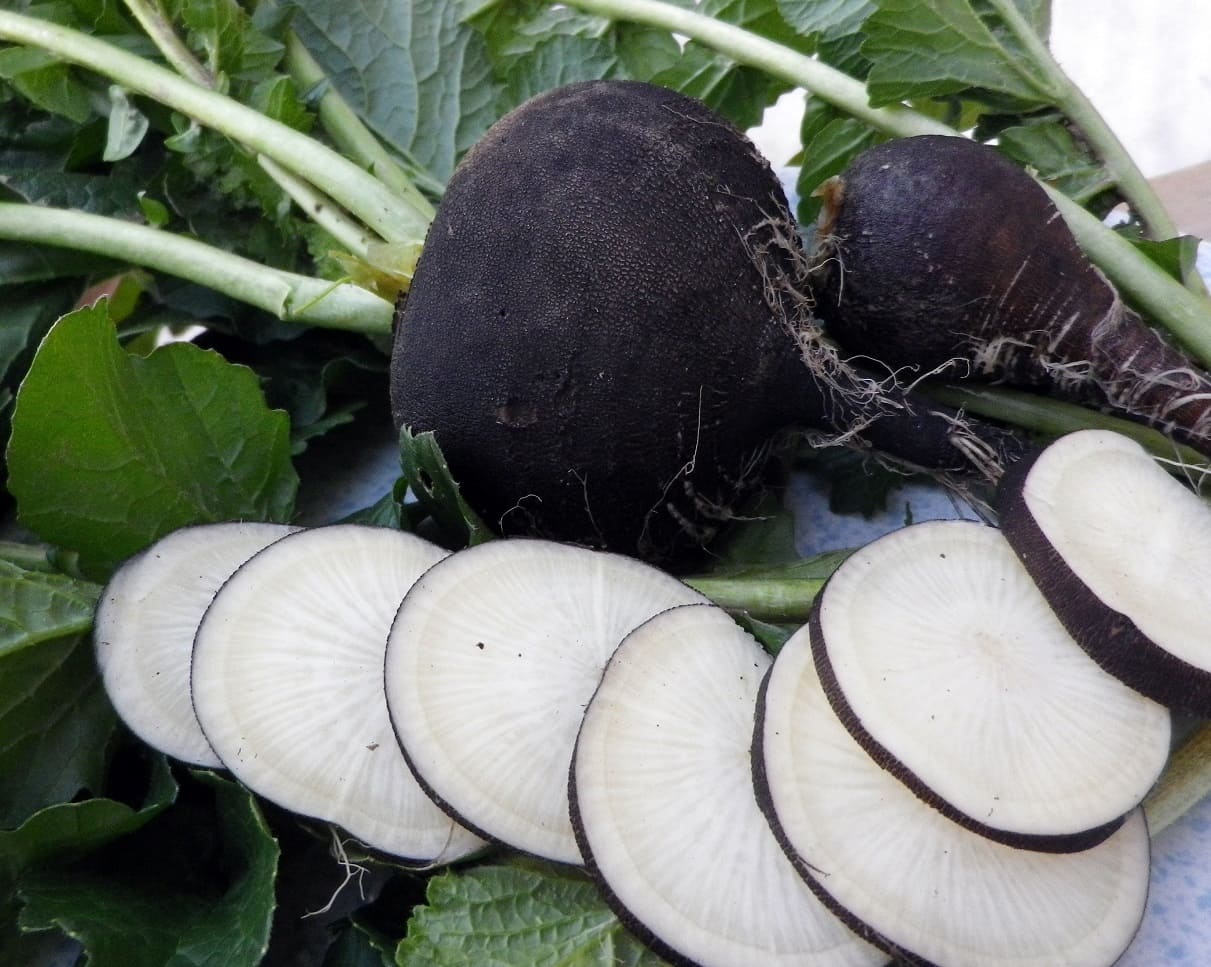
Spanish Black Round varieties also come in elongated forms that can grow quite large while maintaining their characteristic black skin and white interior—these are often found in European seed catalogs under names referencing their storage capabilities.
Daikon (Japanese Radish)
The name literally translates to “big root” in Japanese, and these certainly live up to it. Daikon varieties typically form long, white, cylindrical roots resembling thick carrots, with some specimens reaching 18 inches or more in length.
Their mild, slightly sweet flavor and crisp texture make them incredibly versatile—slice them paper-thin for salads, pickle them for traditional Asian condiments, or simmer chunks in soups and stir-fries. Popular cultivars include ‘Miyashige,’ which produces uniform 16-inch roots, and the faster-maturing ‘April Cross.’
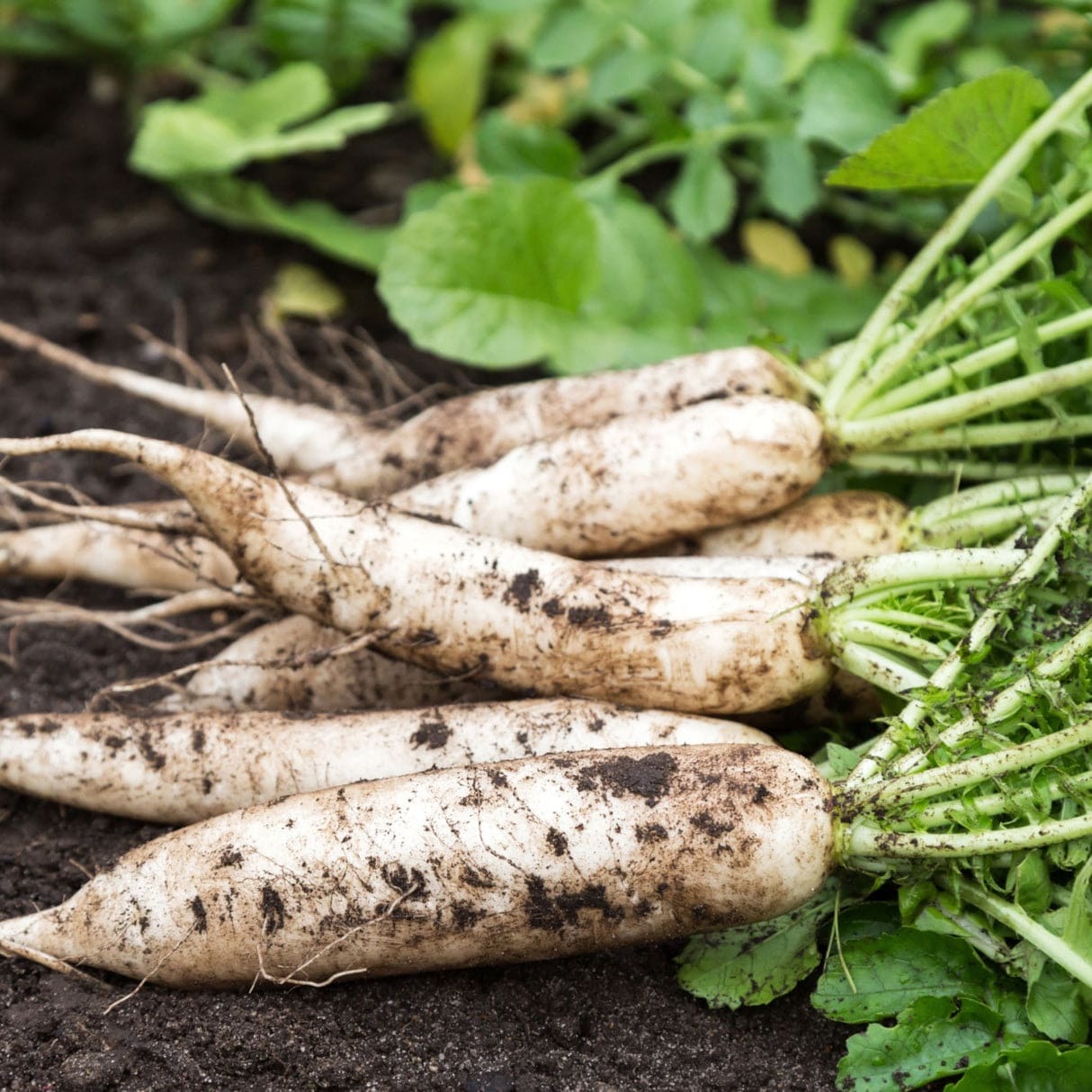
Watermelon Radish
Don’t let the unassuming pale green exterior fool you—slice into a watermelon radish and you’ll reveal a stunning burst of hot pink and magenta radiating from the center, ringed with vivid green at the edges.
This Chinese heirloom (sometimes called ‘Red Meat’ or ‘Shinrimei,’ meaning “beauty in the heart”) offers mild peppery flavor with subtle sweetness. Its visual drama makes it perfect for adding color to winter salads, crudité platters, or simply showcasing on avocado toast. Roasting enhances its natural sweetness even further.
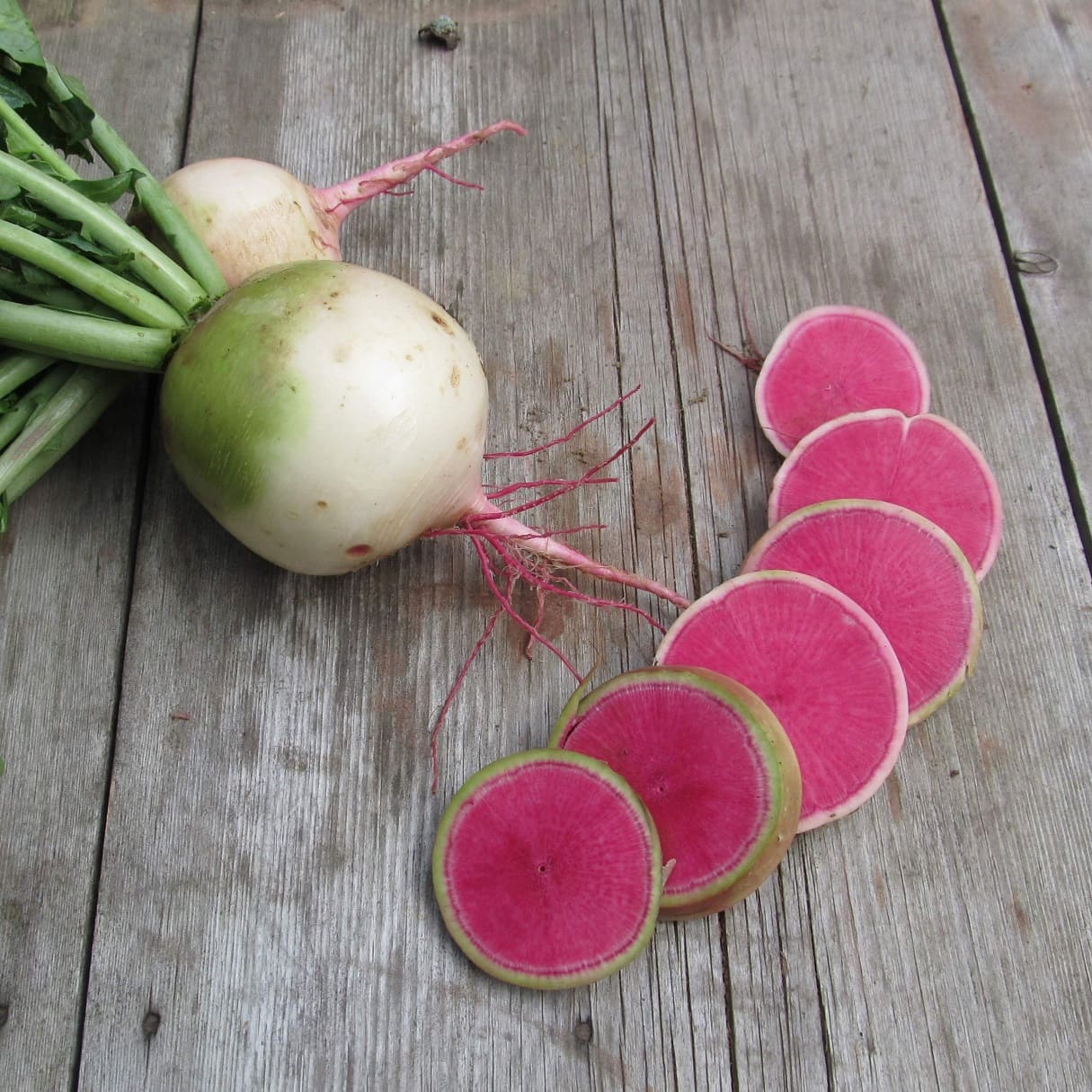
China Rose (Rose d’Hiver)
These oblong beauties sport dusty pink skin that fades to white at the bottom, with crisp white flesh inside. Growing 4 to 6 inches long and about 2 inches in diameter, they strike a nice balance between the giant daikons and smaller varieties.
Their moderately spicy flavor works wonderfully both raw and cooked, and they’re traditional stars in fermented preparations and quick pickles.
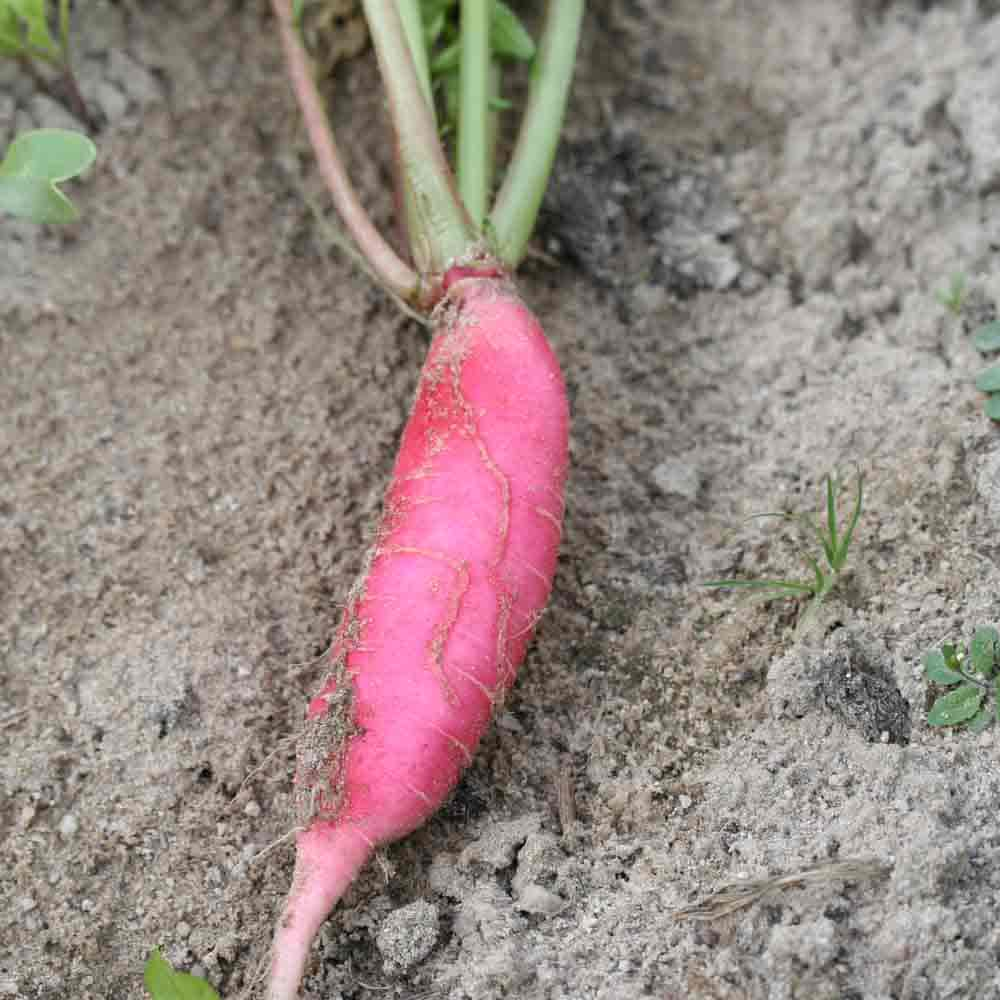
Green Luobo (Green Meat Radish)
An unusual Asian specialty with bright lime green flesh throughout and pale green-white skin, this Chinese heirloom offers upfront sweetness followed by a sneaky heat that builds. It’s particularly prized for kimchi-making and fresh eating when you want something that stands out from the typical white radish.
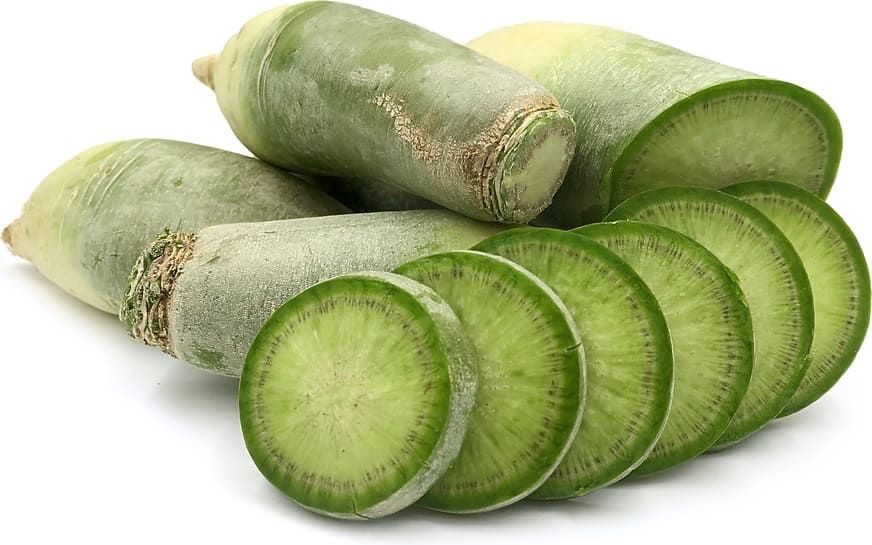
Why Bother Growing Winter Radishes?
Beyond their culinary versatility, winter radishes offer several compelling reasons to claim garden space:
Extended Harvest Season
While most vegetables surrender to frost, winter radishes keep producing. In mild climates, they’ll continue growing slowly through winter.
In colder zones, they can remain harvestable in the ground under mulch until soil freezes solid, or be stored for months after lifting. This means fresh, crunchy vegetables when you need them most—during the dreary depths of winter when local produce options dwindle.
Exceptional Storage Qualities
Properly stored in a cool, humid environment (like a root cellar, refrigerator, or unheated basement), winter radishes maintain quality for three to six months.
Trim the greens, pack roots in slightly damp sand or store in perforated plastic bags at just below 40°F, and you’ve secured a reliable vitamin C source through spring. The flavor often improves in storage as starches convert to sugars.
Nutritional Powerhouses
Winter radishes deliver impressive nutrition for minimal calories. A cup of daikon provides about 25 milligrams of vitamin C (roughly 40% of your daily needs), along with folate, potassium, calcium, fiber, and various B vitamins.
They contain antioxidants and glucosinolates—the same beneficial sulfur compounds found in other cruciferous vegetables that show promise in supporting cellular health.
Soil Improvement Superstars
Here’s where winter radishes reveal their secret superpower: those deep, thick taproots are phenomenal at breaking up compacted soil. Some growers plant varieties like ‘Groundhog’ specifically as a cover crop or green manure, letting the roots drill 12 to 20 inches down (with thinner portions reaching even deeper).
When winter kills the plants, the decomposing roots leave vertical channels that improve drainage, aeration, and make life easier for next season’s crops. They also scavenge residual nitrogen from deep soil layers, preventing nutrient leaching while storing it for release after they decompose—a natural fertilizer system.
Complete Edibility
Nothing goes to waste with winter radishes. The roots are obvious, but the leafy greens taste similar to chard when cooked—slightly peppery but tender, perfect for sautés, soups, or even pesto. Let some plants bolt, and you’ll get seed pods (similar to pea pods) that add peppery crunch to salads. Even the flowers are edible and attract beneficial pollinators.
How to Grow Winter Radishes Successfully
Growing winter radishes requires a shift in thinking from spring varieties, starting with timing:
When to Plant
The critical factor is sowing at the right time so plants mature during cooling weather, not summer heat. Count back from your first expected fall frost: most winter radishes need 60 to 80 days to mature, so you’ll typically sow between mid-July and early September depending on your variety and location.
In warmer climates (zones 8-10), you can push sowings into October. Sowing too early invites bolting; too late means undersized roots before growth stops.
Soil Preparation
Winter radishes demand deep, loose, fertile soil for their substantial roots to develop properly. Work the ground to at least 12 inches deep, breaking up any compacted layers and removing rocks or debris that could cause roots to fork or become misshapen.
These radishes particularly struggle in heavy clay unless you’ve amended it generously with compost or aged manure to improve structure.
Mix in 2 to 3 inches of well-rotted organic matter, but avoid fresh manure or high-nitrogen fertilizers which promote excessive leaf growth at the expense of root development. Radishes prefer neutral to slightly alkaline soil (pH 6.5-7.0).
Choose a location receiving at least six hours of sunlight daily, though light afternoon shade is tolerable in warmer regions.
👉 Here’s How to Prepare Land for Planting: A Comprehensive Guide for Gardeners and Farmers
Sowing Seeds
Plant seeds directly where they’ll grow—radishes develop taproots quickly and transplant poorly. Sow seeds about half an inch deep in rows spaced 12 to 15 inches apart. Within rows, space seeds 1 to 2 inches apart initially, as you’ll thin them later.
For varieties forming particularly large roots (like Sakurajima or long daikons), consider wider spacing from the start. Alternatively, broadcast seeds more densely and plan to harvest the thinnings as baby radishes or use the greens. Water the bed thoroughly after sowing to encourage germination, which typically occurs within 5 to 7 days.
Thinning
This step separates success from disappointment. Once seedlings develop their first true leaves (beyond the initial seed leaves), thin to proper spacing—generally 4 to 6 inches between plants for most varieties, though giant types may need 8 inches or more.
Crowded radishes compete viciously for resources, resulting in all foliage and minimal root development. The thinned seedlings make excellent salad additions, so you get an early harvest while improving the main crop.

Watering
Consistent moisture is non-negotiable. Uneven watering—periods of drought followed by heavy rain or irrigation—causes roots to crack and split. Radishes grown under water stress develop woody, excessively pungent, almost inedible roots.
Aim to keep soil evenly moist but not waterlogged, which encourages rot. A layer of organic mulch helps moderate soil moisture and temperature.
👉 Here’s How to Turn Fall Leaves into Soil Enriching Mulch For a Nutrient-Rich Garden
Maintenance
Keep beds well-weeded, especially when plants are young and most vulnerable to competition. Flea beetles may chew tiny holes in leaves; while this rarely affects root development, you can prevent damage by covering young plants with floating row covers immediately after sowing. Trap the beetles outside the fabric, not under it.
Watch for cabbage root maggots in fall plantings, particularly if you’ve had issues with spring brassicas. Mulching with wood ash can help deter them. Rotate plantings to avoid concentrating brassica pests in one area.
Harvesting and Storage Strategies
Winter radishes are ready when they’ve reached the size described on your seed packet—typically anywhere from 2 inches to over 6 inches in diameter depending on variety. The “shoulders” (tops of the roots) often push above the soil surface when they’re mature.
Unlike spring radishes that turn pithy quickly, winter types maintain quality for several weeks in the ground, giving you flexibility.
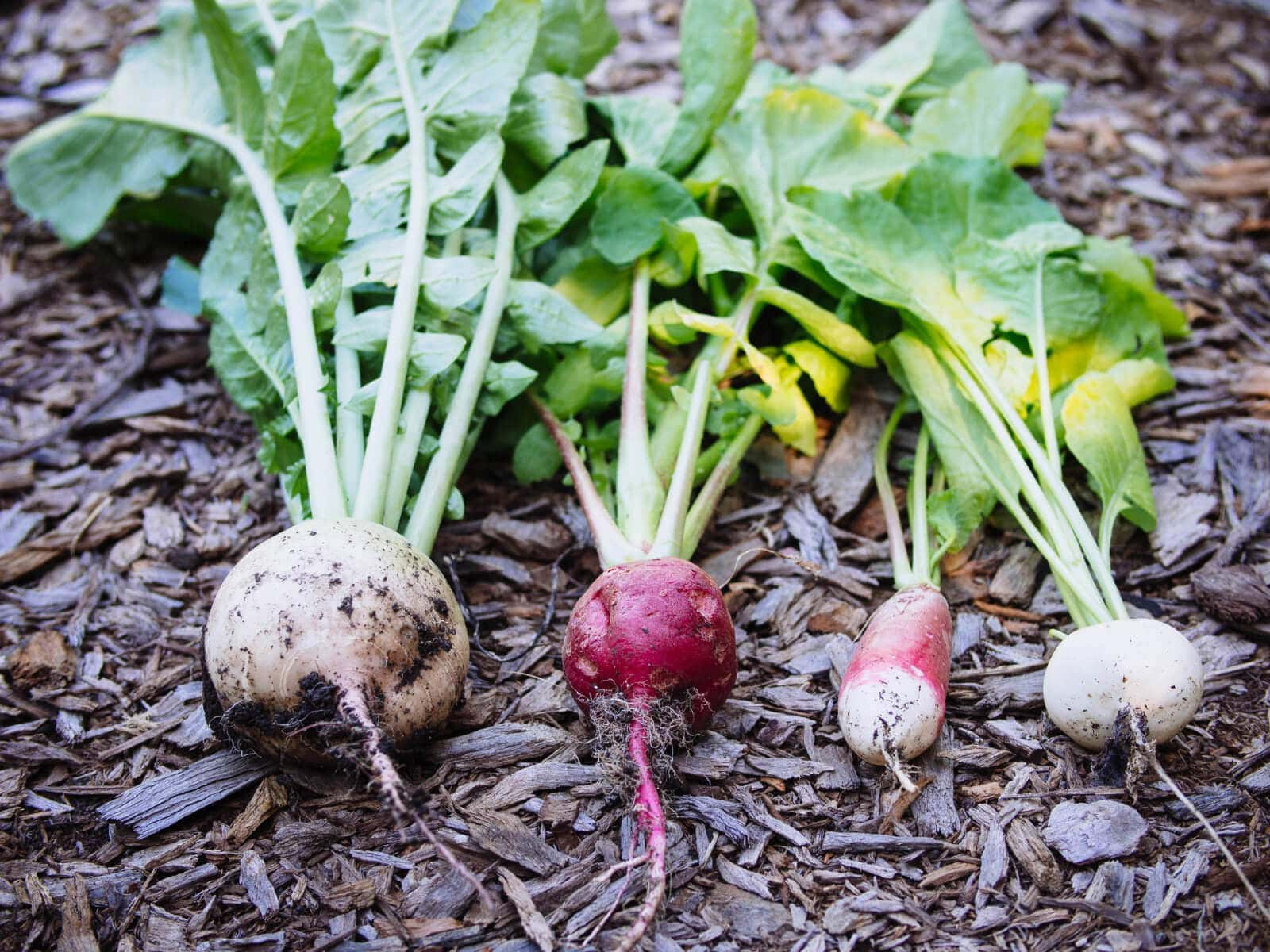
Harvesting Techniques
For short, round varieties, simply grasp the greens close to the root and pull steadily upward. Longer daikon types may need careful digging with a garden fork, especially if your soil is heavy.
Insert the fork several inches away from the root and lever gently to avoid snapping the radish—they’re surprisingly brittle despite their size. Damaged roots can still be used immediately or will heal and store if the break is clean.
Harvest before soil freezes solid. In zones 7 and warmer, you can leave roots in the ground with a thick straw or leaf mulch (8 to 12 inches) for protection, then dig as needed through winter. This works beautifully when you have a small harvest and want maximum freshness. In colder zones, lift all roots before hard freezes arrive.
Storage Methods
For long-term storage, trim foliage to about an inch above the root (leaving too much green draws moisture from the root during storage). Don’t wash them yet—brush off excess soil and leave them slightly dirty for better keeping.
Layer roots in boxes of barely damp sand, sawdust, or peat moss, making sure they don’t touch each other. Store in a location maintaining 32 to 40°F with high humidity—a root cellar is ideal, but an extra refrigerator or unheated basement also works.
Alternatively, store cleaned, dried roots in perforated plastic bags in your refrigerator’s crisper drawer. They’ll maintain quality for several weeks this way, though not as long as sand storage. Check stored radishes periodically and remove any showing signs of softening or rot.
The greens don’t store well and should be used within two to three days. Separate them from roots immediately after harvest, rinse well, and refrigerate in a produce bag with a dry paper towel.

Cooking and Using Winter Radishes
Winter radishes shine in applications where spring varieties would fail. Their firmer texture and more complex flavor profile open up culinary possibilities:
Raw Preparations
Sliced paper-thin, winter radishes add refreshing crunch to salads and slaws without overwhelming other ingredients. The watermelon variety is particularly stunning when showcased this way—arrange thin rounds on a platter with good olive oil and flaky sea salt for an elegant appetizer.
Grate daikon or China Rose radishes for coleslaw, or julienne them for fresh spring rolls and Vietnamese banh mi sandwiches.
One classic preparation is the radish sandwich: thinly sliced radishes layered on buttered bread (preferably rustic artisan loaf) with coarse salt. Simple but utterly satisfying, especially with milder varieties. For spicier black radishes, consider pairing with sharp cheddar and dark beer, German Oktoberfest-style.

Cooked Applications
Here’s where winter radishes truly distinguish themselves. When roasted, braised, or sautéed, their peppery bite mellows dramatically while they develop a tender, almost buttery texture. Try these approaches:
- Roasting: Cut radishes into wedges, toss with olive oil, salt, and pepper, then roast at 400°F for 35 to 45 minutes until golden and tender. Finish with butter, honey, and grated Parmesan for a side dish that converts skeptics.
- Braising: Simmer chunks in broth with aromatics until tender, then reduce the liquid to glaze them. Their starchy quality works similarly to turnips or potatoes.
- Stir-frying: Slice radishes and quick-cook in hot oil with ginger, garlic, and soy sauce. They maintain pleasant crunch while losing their raw sharpness.
- Soups and stews: Add cubes of radish during the last 20 minutes of cooking. They absorb surrounding flavors beautifully while contributing their own earthy sweetness.

The greens deserve attention too. Wash them thoroughly (they collect grit), chop, and sauté with garlic and olive oil until wilted. Season with salt, pepper, and a squeeze of lemon. Or blend raw greens with garlic, nuts, Parmesan, and olive oil for a peppery pesto variation.
Fermented and Pickled
Winter radishes excel in preservation. Daikon is essential for authentic kimchi and Japanese takuan pickles. The simplest quick pickle requires just thinly sliced radishes, rice vinegar, sugar, and salt—let them sit a few hours and they’ll keep refrigerated for weeks.
For traditional Vietnamese pickled daikon and carrot (đồ chua), julienne the vegetables, sprinkle with salt and sugar, let drain, then cover with a brine of equal parts vinegar and water sweetened with sugar. They’re ready in a few hours and keep for a month.
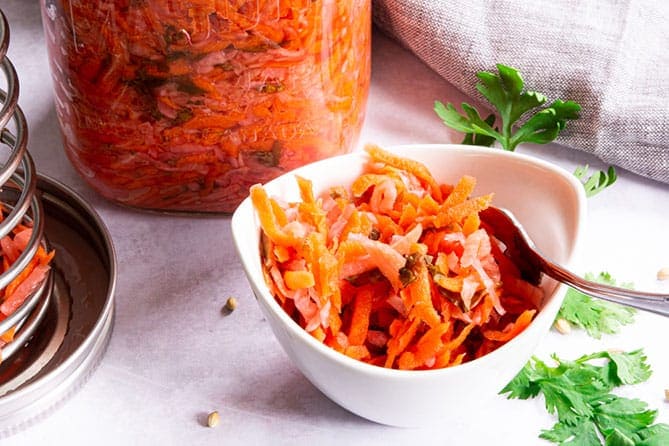
Troubleshooting Common Issues
- Roots Don’t Develop
Usually caused by overcrowding, heat stress, or insufficient water. Thin plants properly, sow at the right time for your climate, and maintain consistent soil moisture.
- Plants Bolt (Flower Prematurely)
Bolting results from sowing too early when days are still long and temperatures high, or from early heat waves. Stick to recommended planting windows. If plants do bolt, let a few go to seed—the seed pods are delicious in salads.
- Woody, Pithy, or Excessively Hot Roots
These are stressed radishes, usually from slow growth due to drought, poor soil, or harvesting too late. Water consistently and harvest promptly when they reach maturity.
- Split or Cracked Roots
Caused by irregular watering—periods of drought followed by heavy moisture. Maintain even soil moisture throughout growth. Split roots are still edible if not rotted.
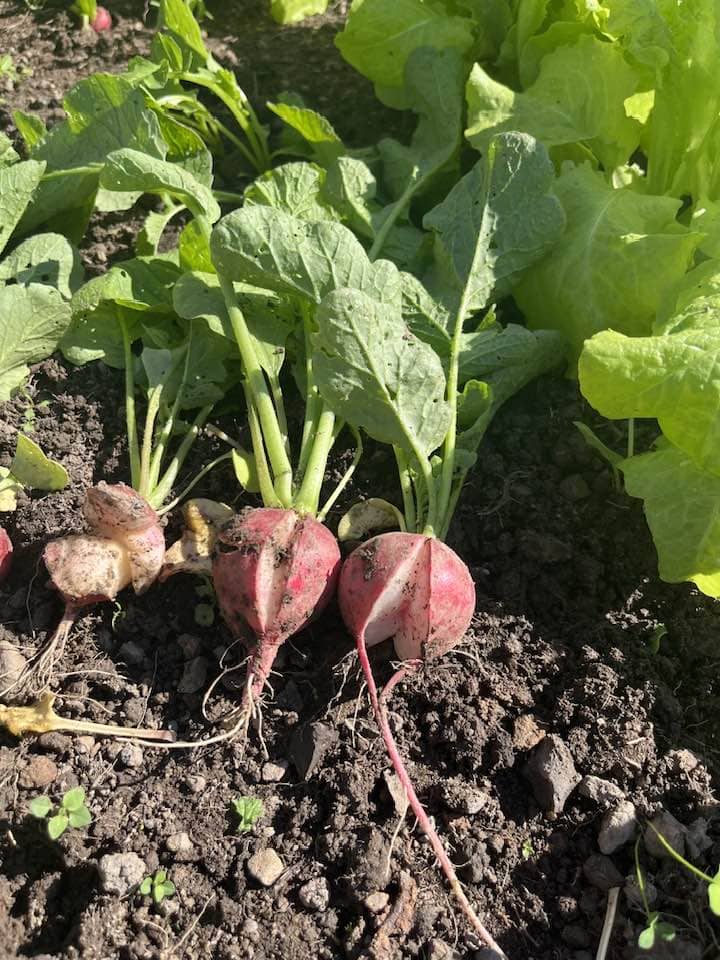
- Pest Damage
Flea beetles create tiny holes in leaves but rarely harm root development. Use row covers for prevention. Cabbage root maggots tunnel into roots and are more serious—use collars around seedlings or apply wood ash mulch. Slugs may attack in damp conditions; trap or hand-pick them.
FAQ: Winter Radish Questions Answered
- Can I grow winter radishes in spring?
Most winter varieties will bolt if spring-planted due to lengthening days and warming temperatures. They’re bred specifically for fall’s shortening days and cooling conditions. However, some varieties like ‘Shunkyo Semi-Long’ resist bolting and can be grown spring through fall.
- Do winter radishes really need frost to taste good?
While not required, many varieties do sweeten noticeably after frost exposure as starches convert to sugars. This is especially true of varieties like the Chinese Shawo Fruit radish. However, they’re perfectly tasty before frost too—you’ll just notice enhanced sweetness afterward.
- How do I know which variety to choose?
Consider your intended use: For raw eating and showcasing color, try watermelon or purple daikon varieties. For versatile cooking, white daikon is reliable. If you want something with real bite that works like horseradish, grow black Spanish varieties. For a balance of beauty and flavor, China Rose is hard to beat.
- Can winter radishes be grown in containers?
Yes, though choose shorter varieties rather than long daikons that need deep root space. Use containers at least 12 inches deep and wide, filled with quality potting mix. Round varieties like watermelon radish or Black Spanish work particularly well in pots. Water more frequently than in-ground plantings.
- What’s the difference between winter radishes and turnips?
While both are cool-season root crops, turnips (Brassica rapa) are more closely related to cabbage, while radishes are Raphanus sativus. Radishes typically have crisper, juicier texture and more peppery bite, while turnips are starchier and sweeter. Nutritionally and in growing requirements, they’re quite similar.
- My radishes grew huge but taste terrible—what happened?
Likely a combination of variety selection and growing conditions. Some varieties (particularly black Spanish types) are naturally very pungent when raw. Also, any radish stressed by heat, drought, or slow growth becomes unpleasantly hot and woody. Choose milder varieties and ensure optimal growing conditions next time.
Embrace the Winter Harvest
Winter radishes represent one of those rare vegetables that actually improves garden diversity without demanding much effort or space.
They fill the gap between fall harvest and spring planting, providing fresh produce when little else is available. Their versatility—from raw to cooked, from pickling to fermenting—means you’ll never tire of them despite a months-long harvest window.
Key Takeaways:
- Winter radishes differ fundamentally from spring types: larger, slower-growing, better storage, preferring cool conditions
- Popular varieties include Black Spanish, Daikon, Watermelon, and China Rose, each with distinct characteristics
- Plant mid-summer to early fall (July-September typically), 60-80 days before first frost
- Provide deep, loose soil and consistent moisture; thin plants to 4-6 inches apart
- Harvest after 8-12 weeks; can store for months or leave in ground under mulch
- Use raw in salads, cooked in countless ways, or preserved through pickling and fermenting
- Every part is edible: roots, greens, flowers, and seed pods
This winter, instead of accepting the barren garden, plant a patch of winter radishes. Come December, when you pull a crisp, colorful root from cold soil—or retrieve one from your root cellar—you’ll understand why these underappreciated vegetables deserve celebration.
Try roasting a medley of watermelon and black radishes with honey and butter, or pickle some daikon to brighten winter meals.
Your turn: Have you grown winter radishes before? Share your favorite varieties and preparation methods in the comments below, or tell us if you’re inspired to try them this fall. And if this guide was helpful, subscribe for more seasonal growing tips to keep your garden productive year-round!
